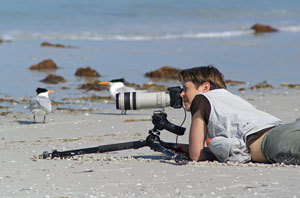Photographer
Tasks & duties

Photographers may do some or all of the following:
-
discuss ideas with clients to understand their aims, and make suggestions
-
look for ideas for pictures
-
decide what method of photography and type of equipment to use
-
organise and set models to photograph
-
arrange camera, lights, the setting and subjects
-
find any props required
-
take photographs
-
develop and print photographs on a film camera, or give a commercial laboratory instructions for photo processing
-
scan photographs into a computer
-
download digital images from the camera onto a computer, then edit and adjust them and print proof sheets
-
save photos onto a CD-ROM or DVD, or email them to their client
-
restore old photographs
-
mount and frame photographs
-
set up exhibitions
-
take photographs for supplying to picture libraries
-
run their own businesses
Specialisations
Photographers may specialise in the following areas:
-
social photography – including weddings or portraiture
-
schools photography – including large group photos or portraiture
-
advertising and editorial – for magazine or newspaper articles, stories or reports
-
fashion photography – for magazines or agencies
-
corporate and commercial photography – for marketing reports and brochures
-
medical, forensic and scientific photography – for police and medical reports that need accurate images
-
press and photojournalism – for recording events and the people involved in them
-
photographic art – for galleries and art sales
-
aerial photography – for mapping or private use
Many photographers in New Zealand specialise in a number of areas to raise their income.
Skills & knowledge

Photographers need to have:
-
knowledge of a variety of photographic equipment such as cameras, flashes, computers, lenses and films
-
knowledge of different photographic effects and how these can be achieved
-
an understanding of how to control artificial light, such as in a studio, and natural light
-
an understanding of the film developing process
-
up-to-date knowledge of the latest photographic methods and equipment
-
knowledge of styles or trends in photography and art
-
skill using computer software such as Photoshop
-
technical skills
-
basic maths skills
-
communication skills
-
good problem-solving and time management skills
Photographers who run their own business also need to have good business skills.
Entry requirements
To become a photographer you need to be able to show you have an eye for photography. If you have no published work, it is useful to put together a portfolio of photographs showcasing your ideas and style, so prospective employers can see what you can do.
Some employers may prefer you to have a formal art qualification such as a diploma, degree or postgraduate degree in photography or design.
Secondary education
There are no specific secondary education requirements, but art, computer studies, graphic design, maths and English are useful. A tertiary entrance qualification is required to enter further training.
Tertiary education
A number of tertiary photography courses are offered in New Zealand.
Training on the job
Many photographers start off working as photography assistants, and gain skills and experience to broaden their portfolio and become photographers.
Some employers run trainee schemes, and photographers may also attend courses and seminars for motivational purposes and to gather new ideas. It is also important for photographers to keep up to date with new techniques and technology.
Useful experience
Useful experience for photographers includes:
-
amateur photography work
-
work in a darkroom
-
work as a photographic assistant
-
work as a television or motion picture camera operator
-
design work or courses
-
business or computer work
For more information, please refer to Career Services.
Document Actions
